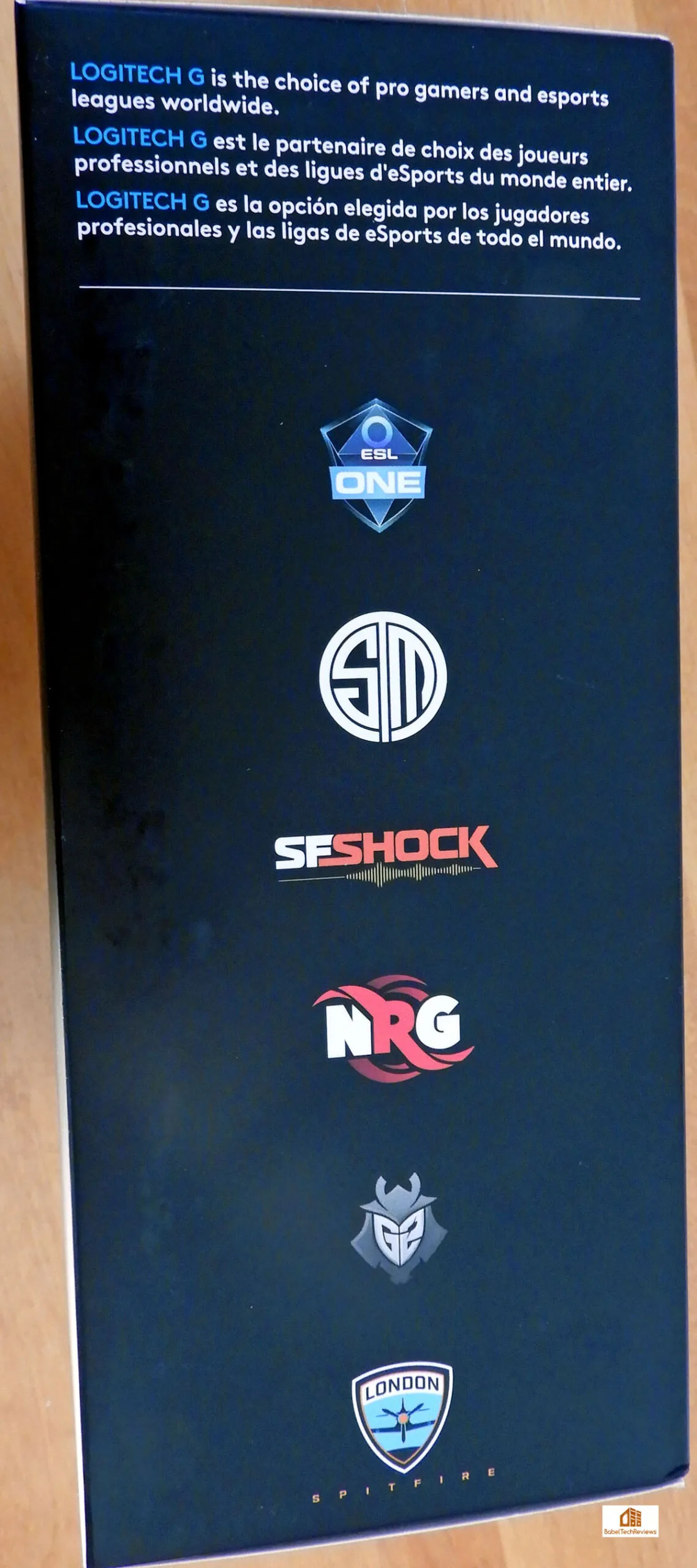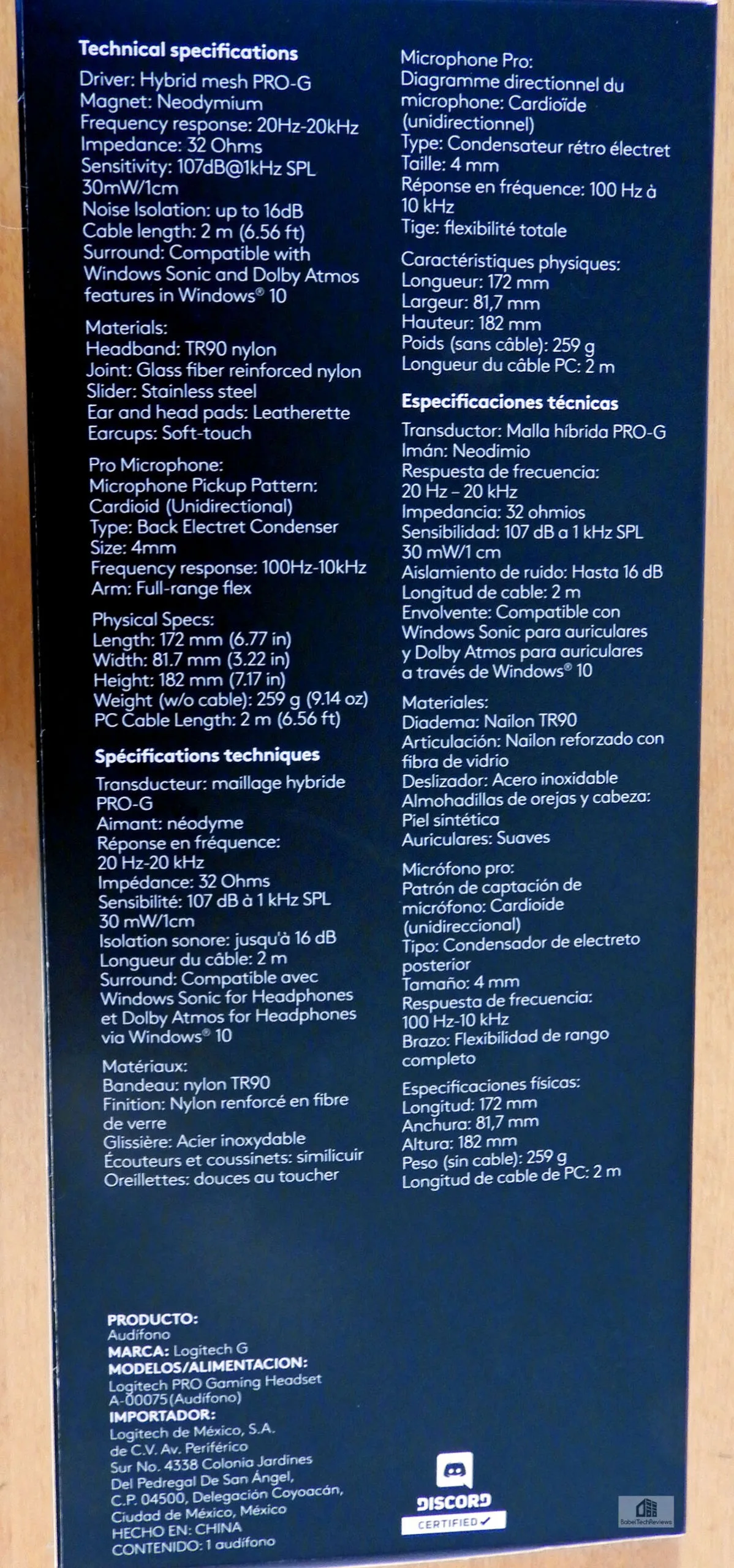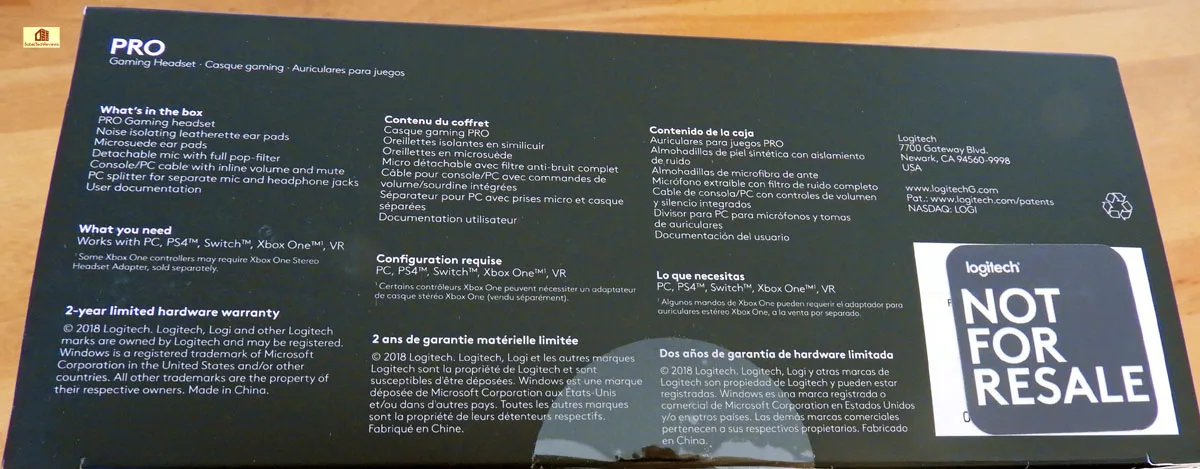The Logitech G PRO Headset Review – Built for Pro Gamers
Logitech released the G PRO gaming headset last year as a less expensive replacement for their flagship G433. The G PRO is a comfortable headset widely available for under $90 which is designed and built primarily for gamers and particularly for multiplayer and for professional eSports gamers. 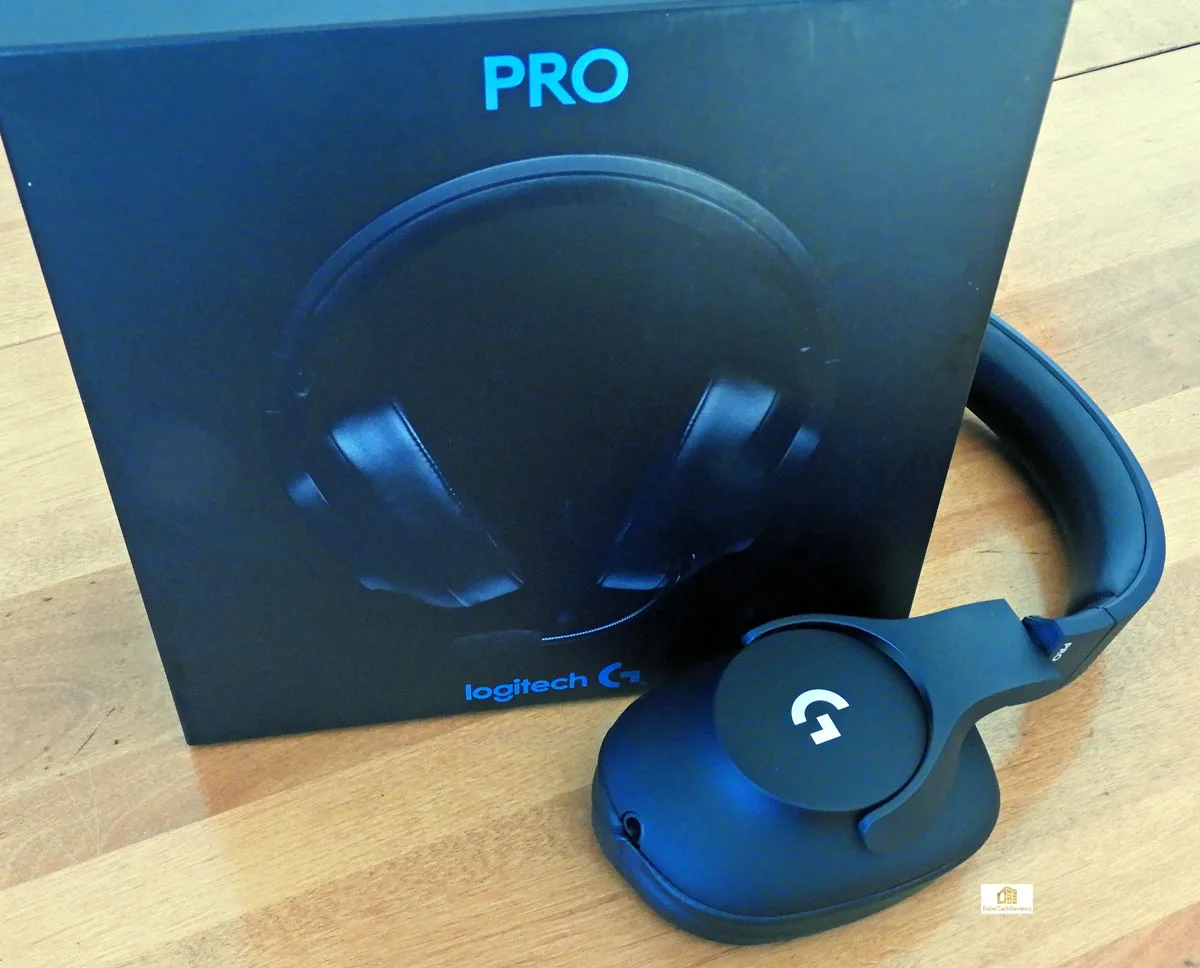 We received an evaluation sample from Logitech last week, and have been using the G PRO for critical music listening as well as to play through parts of single player campaigns of several games that have excellent audio including Alien Isolation and multiplayer games including Call of Duty: Black Ops 4. Because it is nearly impossible to review audio without making comparisons, we compare the G PRO with the original HyperX Cloud headset and also with Grado’s SR60e headphones.
We received an evaluation sample from Logitech last week, and have been using the G PRO for critical music listening as well as to play through parts of single player campaigns of several games that have excellent audio including Alien Isolation and multiplayer games including Call of Duty: Black Ops 4. Because it is nearly impossible to review audio without making comparisons, we compare the G PRO with the original HyperX Cloud headset and also with Grado’s SR60e headphones.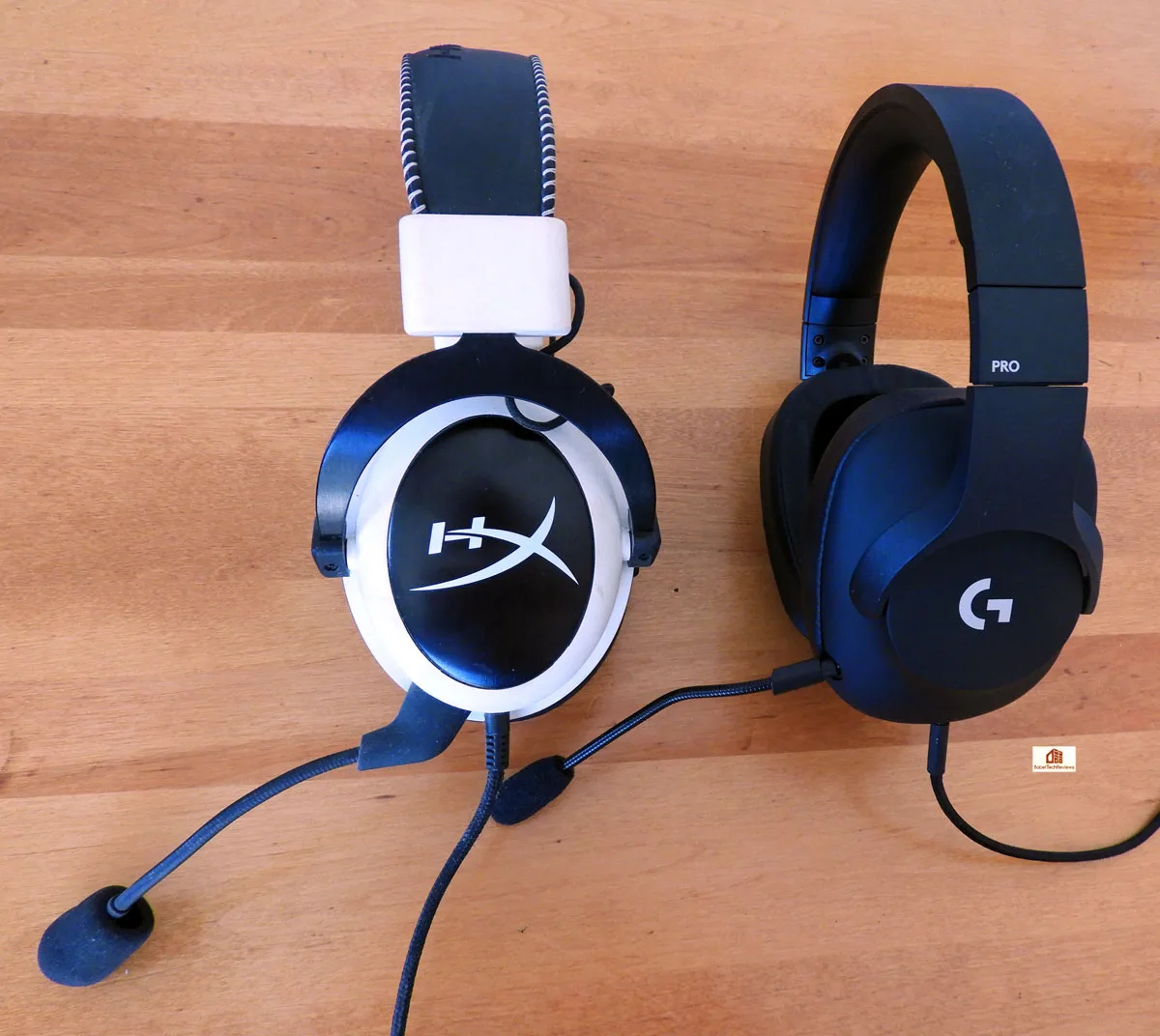
The Logitech G PRO is a closed design headset which features Logitech microfiber and leatherette ear pads, padded headband, and 40mm directional drivers to deliver high-quality gaming sound for under $90.
Most competing headsets like the Cloud II are usually priced at least ten dollars more, and the only difference between the original Cloud that we are comparing today and the Cloud II is a USB connector with 7.1 audio. We don’t particularly like 7.1 audio simulated by two speakers like with Windows Sonic or Dolby Atmos. We much prefer a game’s spacial audio, directionality, and audio cues delivered by two properly placed and tuned stereo drivers as in the Logitech G PRO.
Logitech has attempted to bring a high quality gaming experience with an emphasis on pro gaming and eSports using a no-frills design that is also less expensive than its predecessor, the G433, which Logitech attempted to improve upon. The G433 Logitech is a more expensive headset that has a USB interface and 7.1 audio much like the Cloud II. The G PRO uses the same 40mm drivers as in the G433, but it does away with the interface.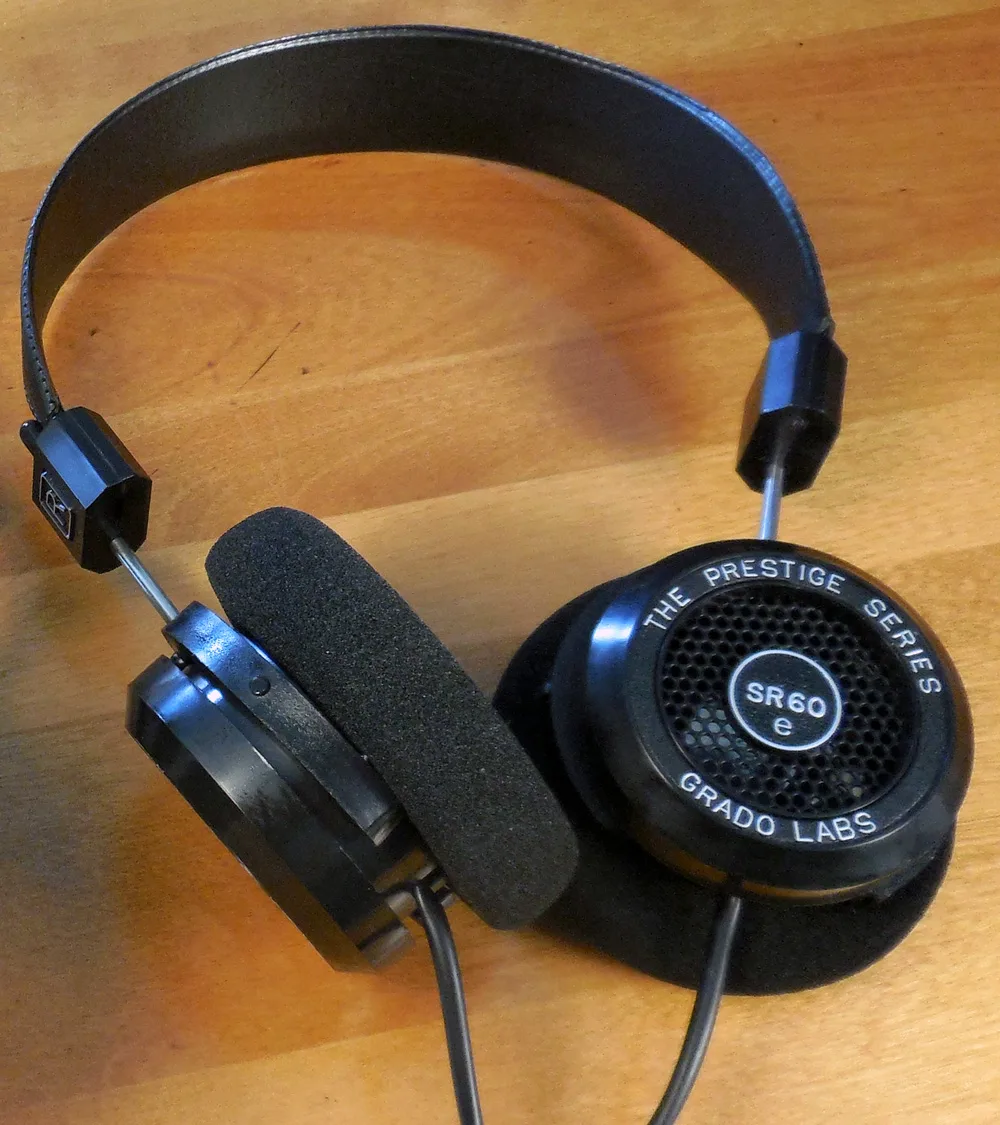
The Grado SR60e is a $79 entry-level audiophile open design headphone using 40mm drivers which is designed primarily for accurate or critical listening to music.
The Cloud and the Cloud II both use 53mm drivers and they boast a frequency response of 15Hz-25,000KHz while the Logitech G433 and PRO G use 40mm drivers and offer 20Hz to 20,000Hz. These specifications are completely meaningless and have no relationship to how they actually sound. We will try to pinpoint the differences in the practical sound quality between the G PRO and the Cloud headset when used for gaming and also compared with the Grado SR60e headphones when used for music.
One thing a gamer may notice is that the Logitech G Pro is slightly louder at the same levels since its speakers are slightly more efficient at 32 Ohms than the ones used for the Cloud. This is actually a plus for using a mobile device or a motherboard’s integrated audio. Our three headsets are analog, so we used our EVGA Z370 FTW motherboard’s Realtech audio and integrated headphone jack as well as our Diamond USB external USB 7.1 digital soundcard.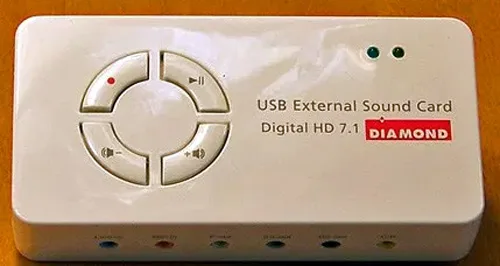
The Logitech G PRO weighing in at just over nine ounces (259 grams) is actually more than two ounces lighter than the Cloud (at 320 grams). A lighter headset can make a big difference to pro gamers who may game for many hours at a stretch. We found the G PRO to be even more comfortable than the Cloud which is a very comfortable headset. We gamed with the G PRO for many hours in each session, and our ears and head still felt good afterward. There was no fatigue whatsoever because of its perfect fit, soft headband, and plush ear cushions.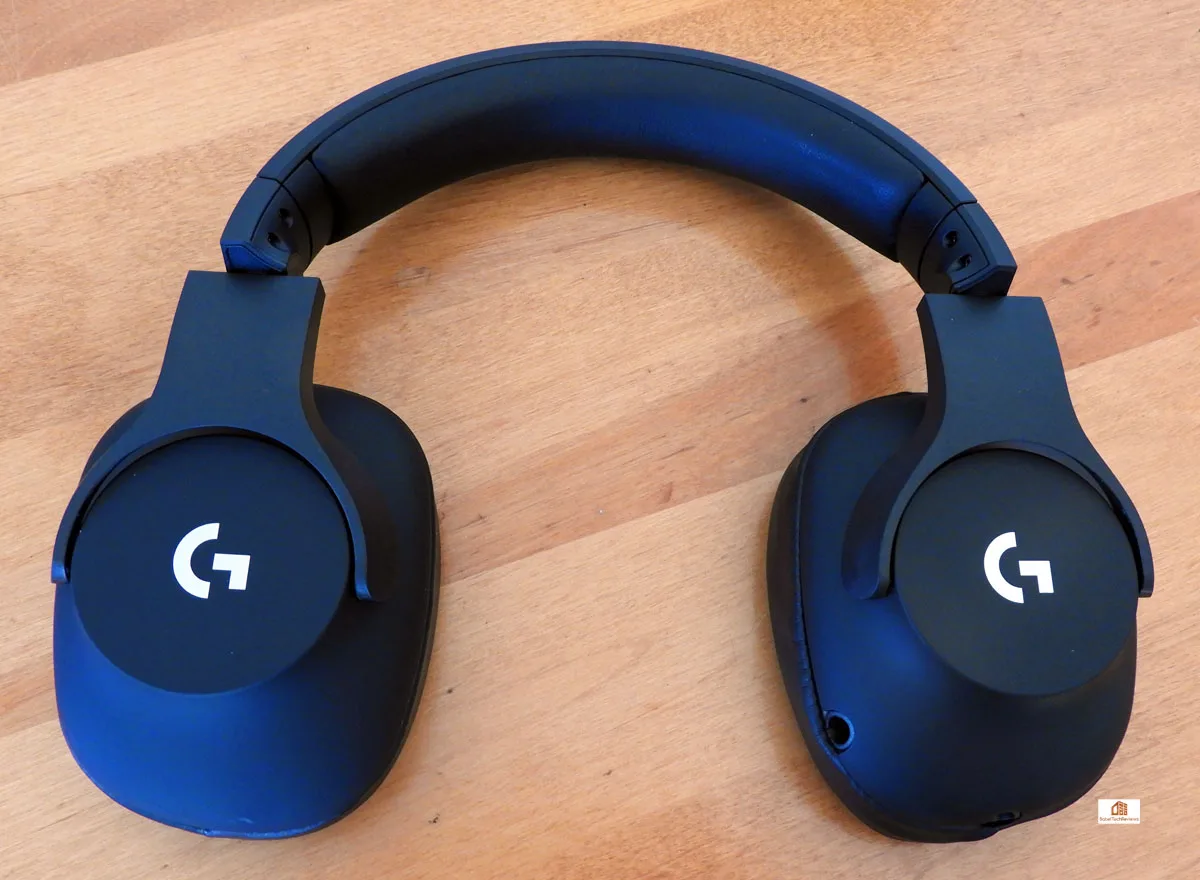
The Logitech G PRO is built with 90-degree rotating ear cups which can lie flat for travel or against ones body which is big plus over our Cloud’s headset whose ear cups cannot lie flat. The Logitech G PRO uses 40mm tuned directional drivers compared to the Cloud’s 53mm drivers, but both are positioned to result in a broad soundstage providing accurate in-game sound. Overall we like the directionality of the G PRO a little better using stereo sound. We don’t particularly care much for Windows Sonic, and we much prefer a stereo soundstage when looking for in-game audio cues.
The Logitech G PRO also offers a convenient set of features for gameplay, including a detachable flexible microphone for single player games, and an adjustable steel headband slider for long lasting durability. The 6.5 foot cable is also braided, sturdy, and detachable. In addition, there is a convenient volume/mute control on the G PRO’s cable which is easy to reach and adjust.
With good audio performance and sound quality, the Logitech G PRO enables positional audio to help competitive gamers gain a spatial sense advantage across any gaming platform. The G PRO has compatibility with the PC, the Xbox One, the PS4, and with other mobile devices.
Logitech G PRO Specifications & Features:
From the Logitech G PRO website:
PHYSICAL SPECIFICATIONS
- Height: 172 mm
- Width: 81.7 mm
- Depth: 182 mm
- Weight: (w/o cable): 259 g
- PC Cable Length: 2 m
HEADPHONE
- Driver: Hybrid mesh PRO-G
- Magnet: Neodymium
- Frequency response: 20Hz-20KHz
- Impedance: 32 Ohms
- Sensitivity: 107dB@1KHz SPL 30mW/1cm
- Noise Isolation: up to 16dB
- Cable length: 2m
- Surround: Windows Sonic and Dolby Atmos for headphones Compatible
MATERIALS
- Headband: TR90 nylon
- Joint: Glass fiber reinforced nylon
- Slider: Stainless steel
- Ear and head pads: Leatherette
- Additional ear pads: Microsuede
- Earcups: Soft-touch
PRO MICROPHONE
- Microphone Pickup Pattern: Cardioid (Unidirectional)
- Type: Back Electret Condenser
- Size: 4mm
- Frequency response: 100Hz-10KHz
- Arm: Full-range flex
REQUIREMENTS
- PC, PS4™, Nintendo Switch™, Xbox One™, VR
PART NUMBER
- 981-000719
WARRANTY INFORMATION
- 2 – Year Warranty
The Logitech G PRO is powered by the audio jack for PC and Mac to amplify audio and voice, as well as stereo compatible for the PS4 and Xbox One. It has a 2m cable to provide stereo input and a short extension cable with dual 3.5mm stereo and microphone plugs when online to communicate with your team.
We can use the G PRO as headphones for travel thanks to its closed design and easily detachable mic boom. If we used the Grado’s open design, we would irritate everyone around us. The G PRO provides very decent isolation from outside noise and it is easy to miss a ringing phone while wearing them. This closed design is ideal for professional gamers who are often in a noisy environment when it is absolutely crucial to be isolated from the rest of the world while concentrating on gameplay.
The Logitech G PRO’s unidirectional microphone is one of the best built-in mics we have used, and when we went on line, our Call of Duty: Black Ops 4 teammates had no trouble understanding or hearing us – even in a very noisy background with the TV on. The mic is best tested and adjusted before a gaming session, and although it is kept around an inch from the player’s mouth there is no distortion, and its full pop filter does its job well. In contrast, the mic on the Cloud tends to pick up background noise, and a player’s voice is not as clear or as distinct to his teammates as it is with the G PRO.
One thing that is important to realize is that both the Logitech G PRO and the Cloud are gaming headsets and are not audiophile headphones. Gaming headsets serve a different more all-around purpose than headphones as they are primarily designed for online gaming, each with a microphone boom so you can coordinate with your team or just chat using Discord. The G PRO is designed to be extraordinarily comfortable for long hours of single player, LAN, or for online gaming.
The Logitech G PRO, although perhaps not as flashy as the Cloud, looks great and it could even be called elegant in all-black with contrasting white logos. However, besides looks it is more important that a headset should sound decent. A gamer does not expect audiophile quality in a $90 headset, nor should one expect thundering bass and shimmering transient highs. The G PRO is primarily a gaming headset designed for comfort and to be able to hear the audio cues, communicate well with teammates, and block out the rest of the world while you concentrate on winning.
Headsets are a good way to experience both music and gaming. Well-built headsets tend to last a long time and one should buy one that is not only pleasing to the ears, but to the eyes. Comfort is absolutely critical for anyone who listens to music or who plays games for more than a few minutes at a time.
The closed-design Logitech G PRO – even more so than the heavier Cloud – excels in comfort as its headband and ear cups are well-padded and they do not pressure the head or ears in any way. The open design Grado SR-60e are also very comfortable but they tend to annoy anyone around the listener as the sound leaks out, and it is also easy to hear what is happening around you. It also means that the Grados need to be used in a very quiet room with no one around – unlike the Logitech G PRO or the Cloud which are designed to be worn in a noisy LAN or a competitive team gaming situation.
However, what about the sound of the Logitech G PRO compared with the Cloud and with the Grado headphones? Head to the next page as we unbox and audition them.
Unboxing, Listening & Gaming Comparison
The Logitech G PRO is available only in black, and it has a symmetrical modern design which delivers a clear and balanced sound for gaming or for music. Below is pictured the Logitech G PRO box which features a picture of the headset in black-on-black. 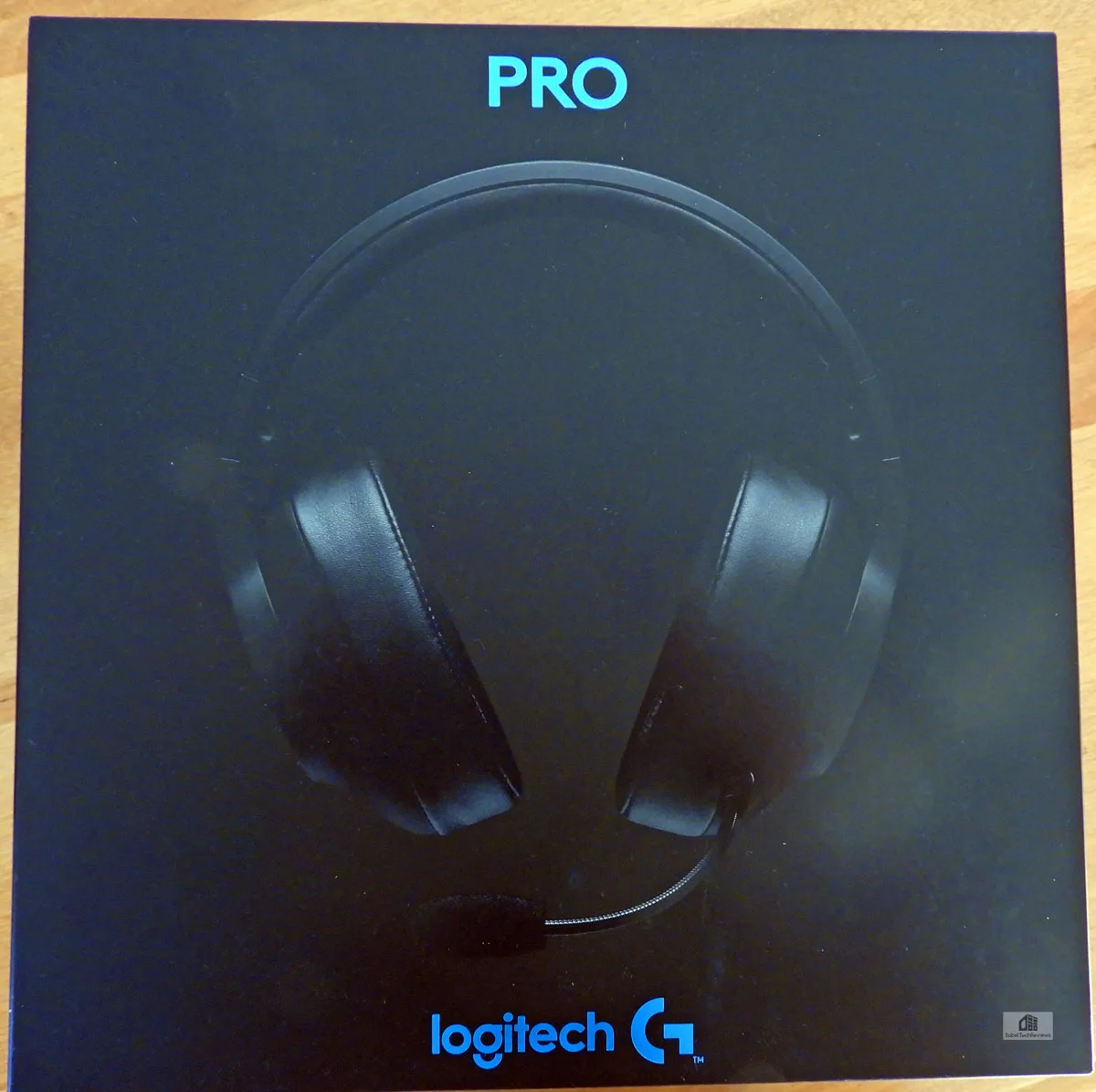 Our camera tends to give the headset a bluish tint which is not present at all as the headphones are black with contrasting white logos. Here is a professional image courtesy of Logitech.
Our camera tends to give the headset a bluish tint which is not present at all as the headphones are black with contrasting white logos. Here is a professional image courtesy of Logitech.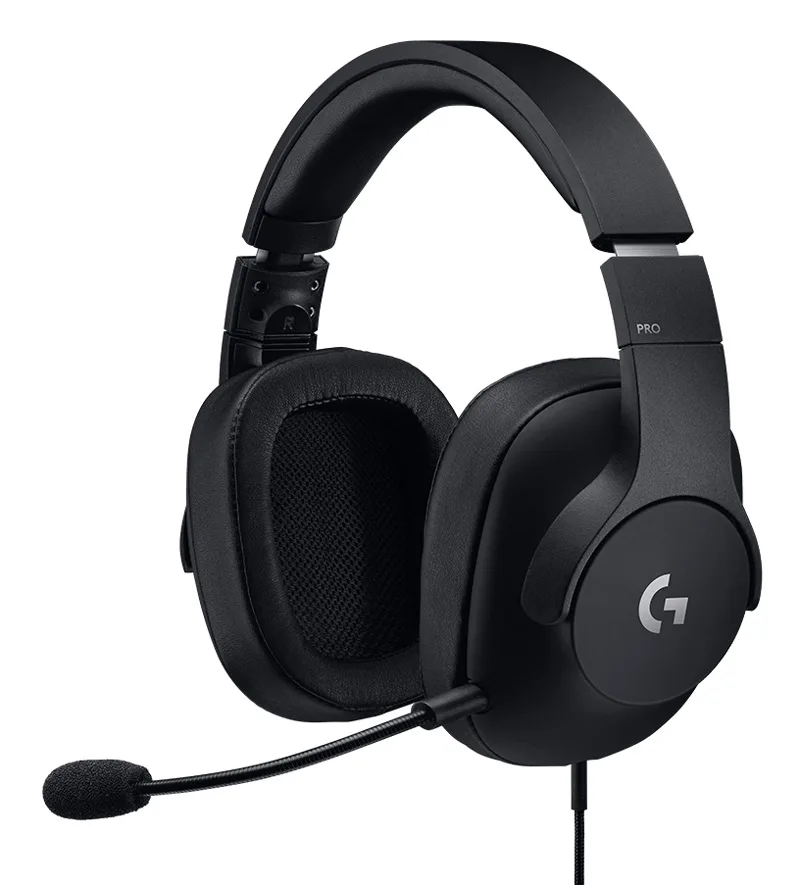
On the reverse side of the box, its quality build, durable construction, and high-quality build components, driver and microphone specifications are listed. The G PRO’s purpose is clearly stated as “Play to Win”. The box is very difficult to photograph being presented in all-black with black lettering. 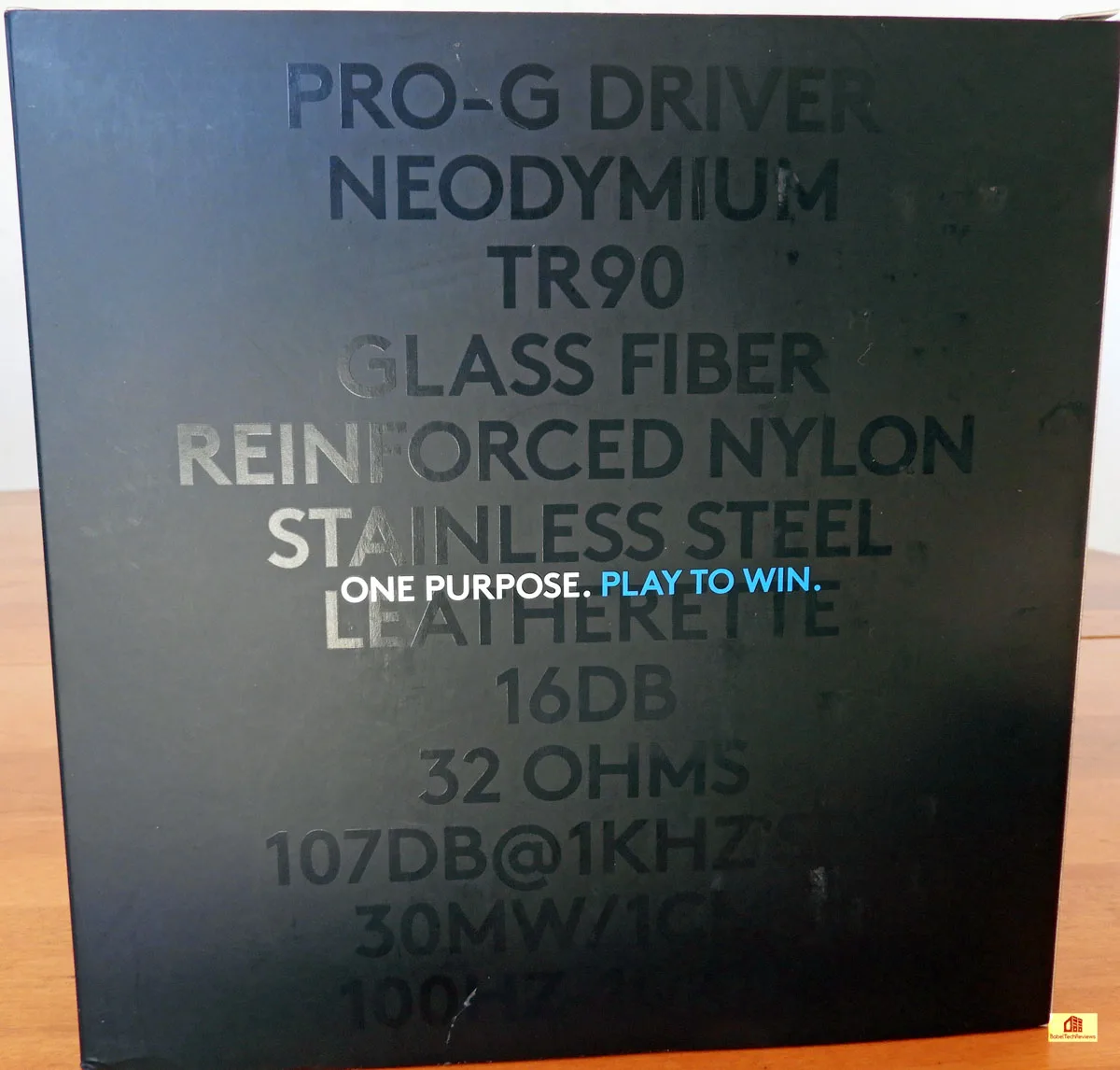 Pictured on the bottom and the end flaps of the Logitech G PRO box which gives more of the headset’s specifications. The 40mm high-performance speaker driver units claim to cover the full-spectrum of sound from 20Hz to 20KHz. These specs are well in-line with industry standards which are mostly designed to impress consumers since they do not mention how far the frequency response vary in decibels at the extreme ends of its measured frequencies. In reality, the G PRO can reproduce relatively clean mid-bass, mid-range, and treble frequencies with reasonable accuracy.
Pictured on the bottom and the end flaps of the Logitech G PRO box which gives more of the headset’s specifications. The 40mm high-performance speaker driver units claim to cover the full-spectrum of sound from 20Hz to 20KHz. These specs are well in-line with industry standards which are mostly designed to impress consumers since they do not mention how far the frequency response vary in decibels at the extreme ends of its measured frequencies. In reality, the G PRO can reproduce relatively clean mid-bass, mid-range, and treble frequencies with reasonable accuracy.
The bottom of the box indicates what is included in the box, and the end flaps give you a further illustration of use and performance indicating that the Logitech G PRO is primarily a gaming headset that is also used by professional gamers. 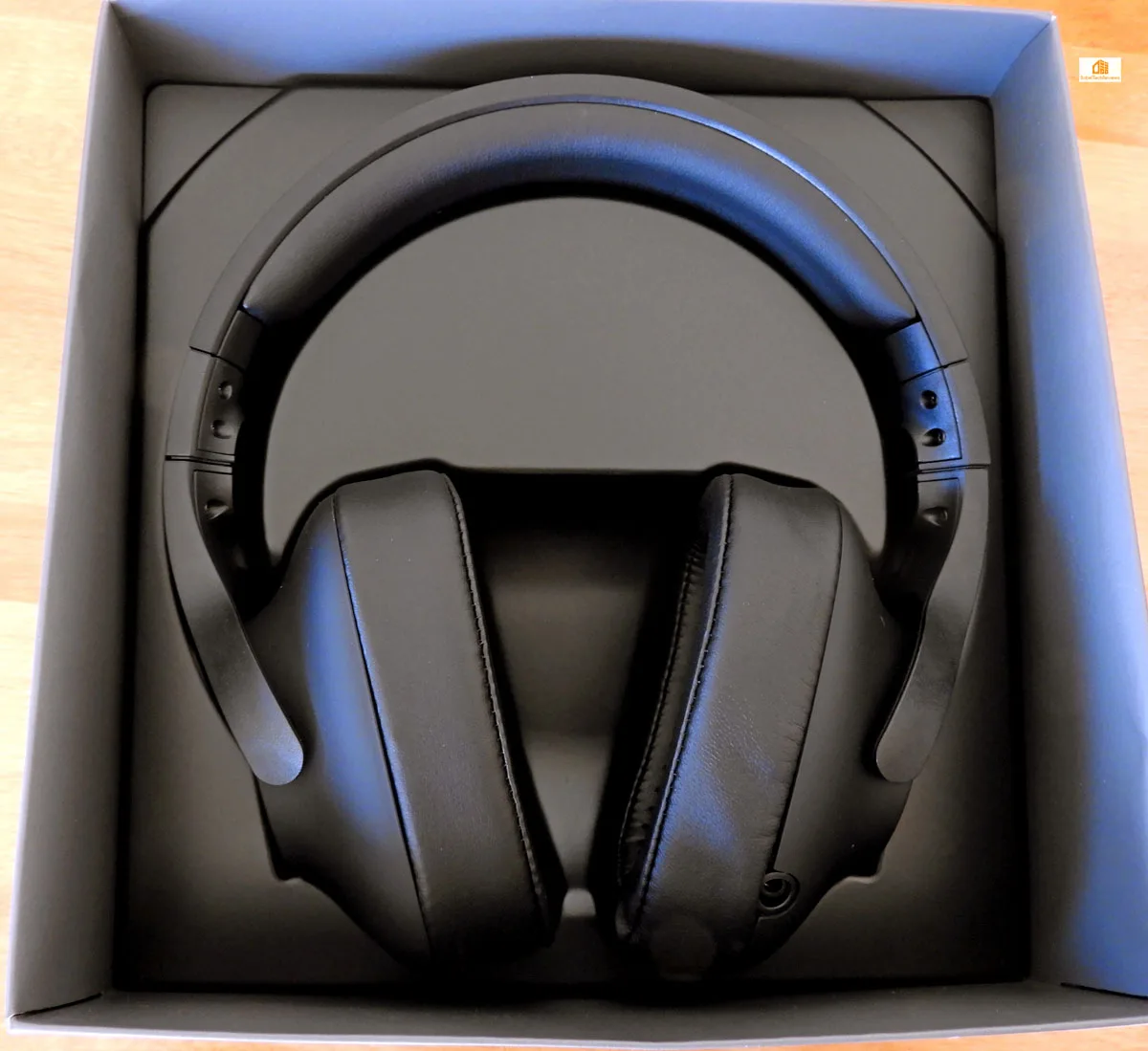 The are no frills, but the contents are well-packed for shipping, and our Logitech G PRO Headset arrived in perfect shape and ready to plug in and listen to music or to begin gaming with. There is a quick installation guide which shows the end user how to set it up.
The are no frills, but the contents are well-packed for shipping, and our Logitech G PRO Headset arrived in perfect shape and ready to plug in and listen to music or to begin gaming with. There is a quick installation guide which shows the end user how to set it up.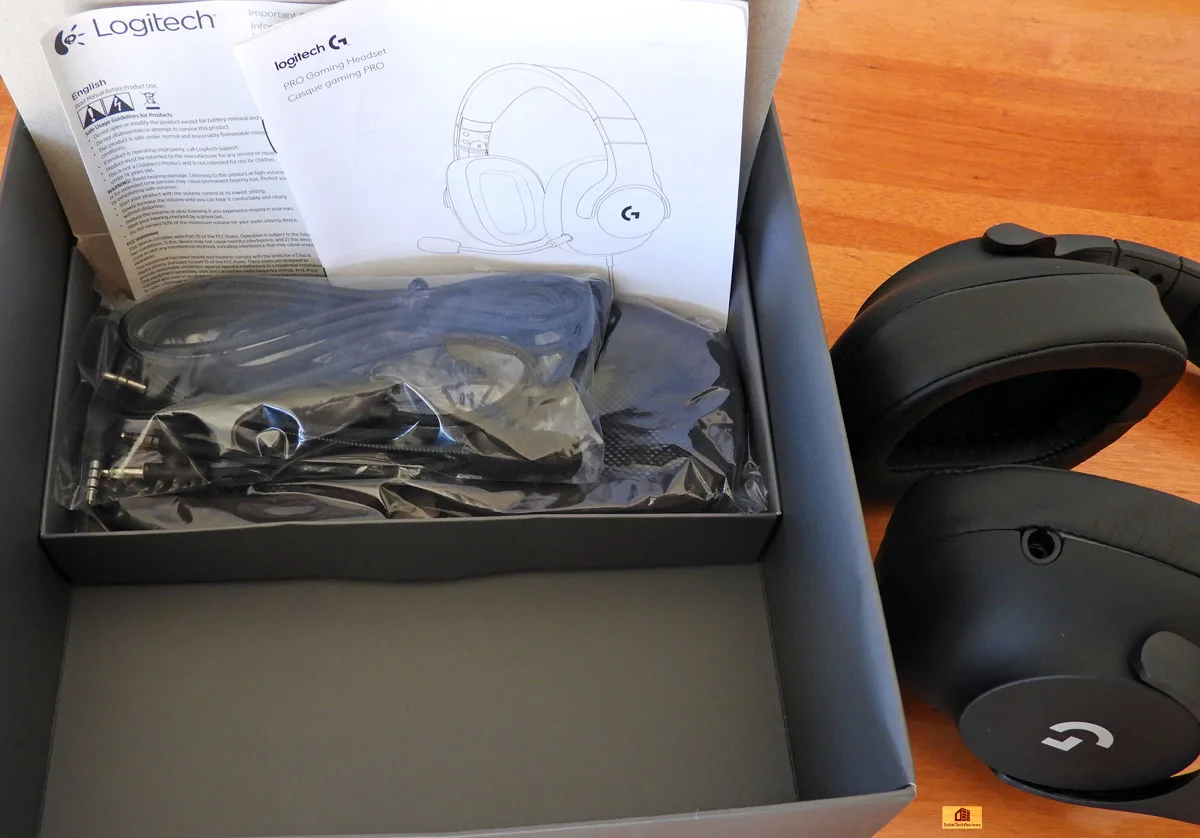
The Logitech G PRO headset draws its power from your device as it contains no amplifier to power its speakers. It is well-built using reinforced nylon for the headband which is padded for comfort and it is easily adjustable by extending a steel band for a custom fit that doesn’t pinch glasses wearers.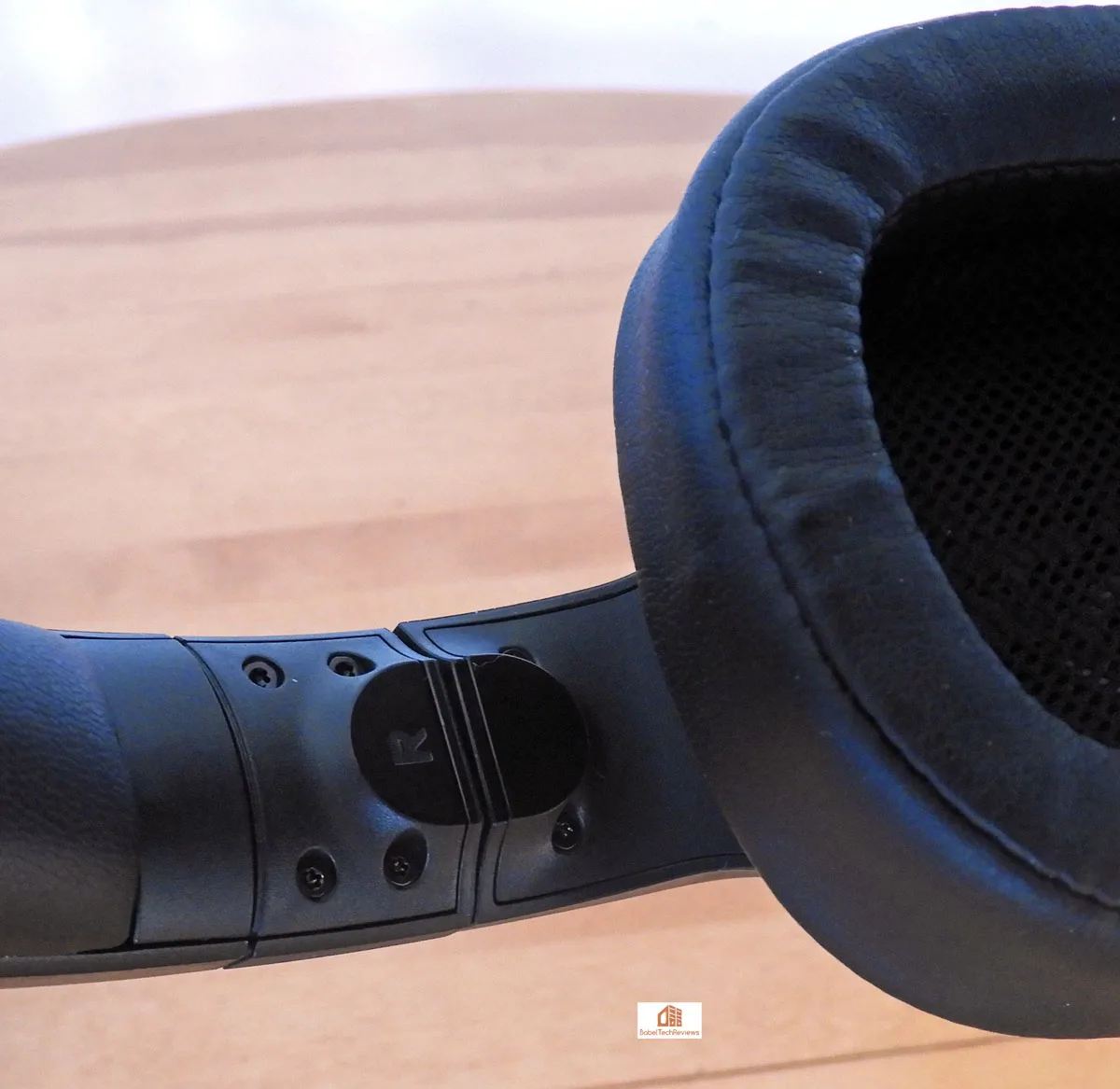
The speaker drivers are visible through the acoustically transparent mesh.
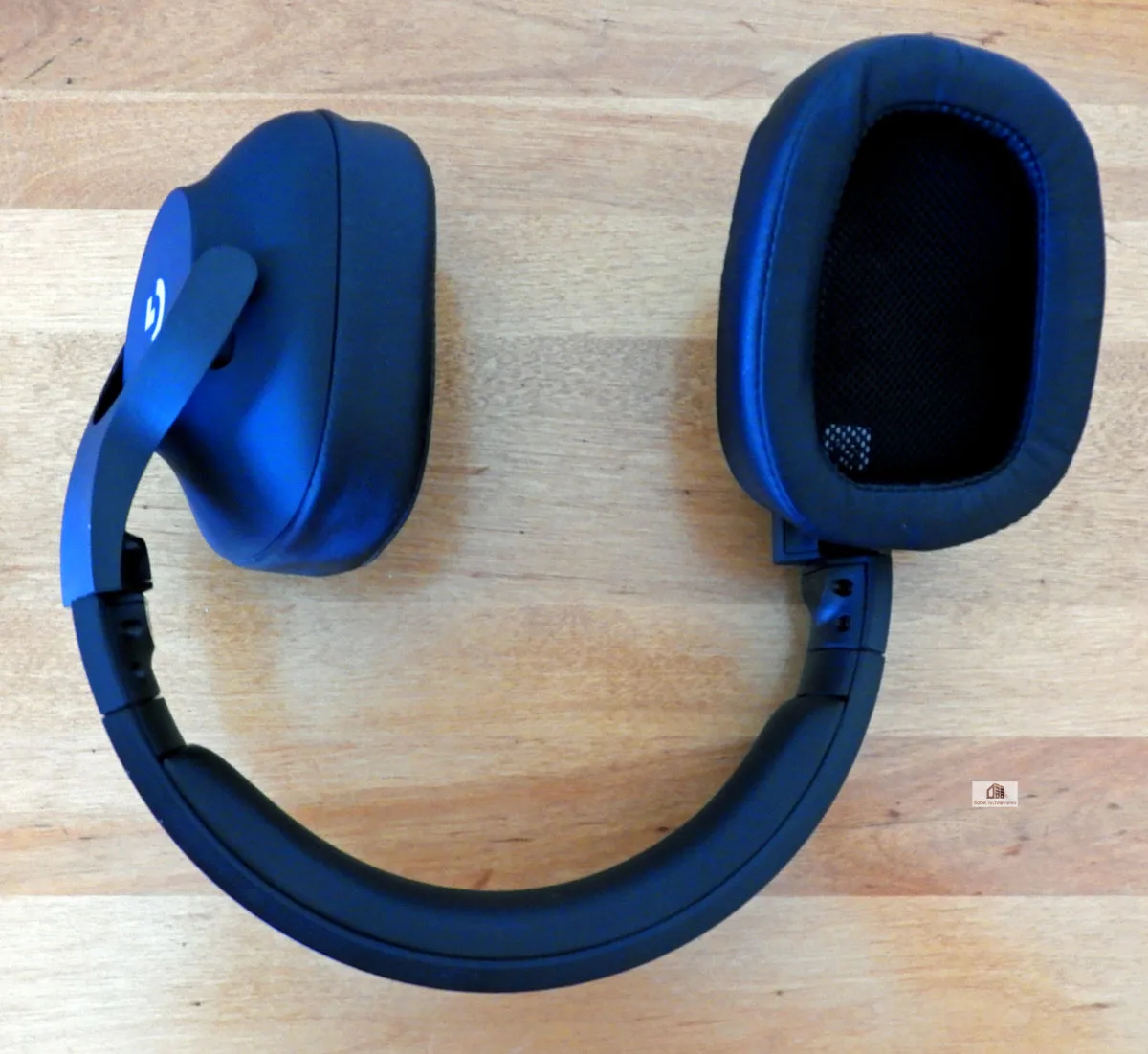 The ear cups swivel 90 degrees and they can lay flat for travel or against your body when you are not wearing them on your head, making them significantly less bulky than the Cloud.
The ear cups swivel 90 degrees and they can lay flat for travel or against your body when you are not wearing them on your head, making them significantly less bulky than the Cloud. 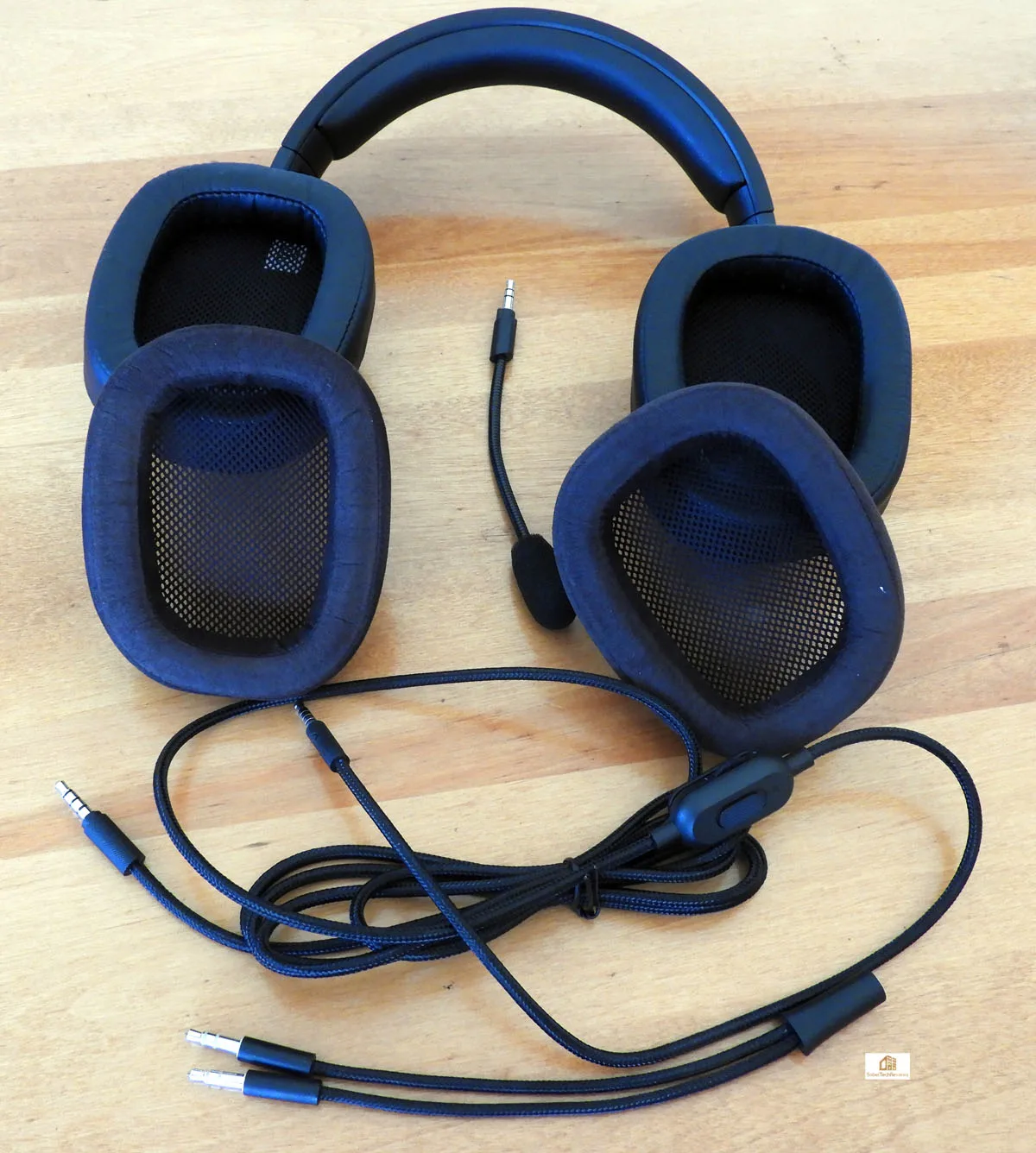
There are two sets of ear pads included. Leatherette is installed on them out of the box, but you can always change them out for the microsuede pads with a little effort by stretching the rubber seals and carefully installing them on the ear cups. The leatherette pads seem to afford a bit more audio isolation and we preferred them. 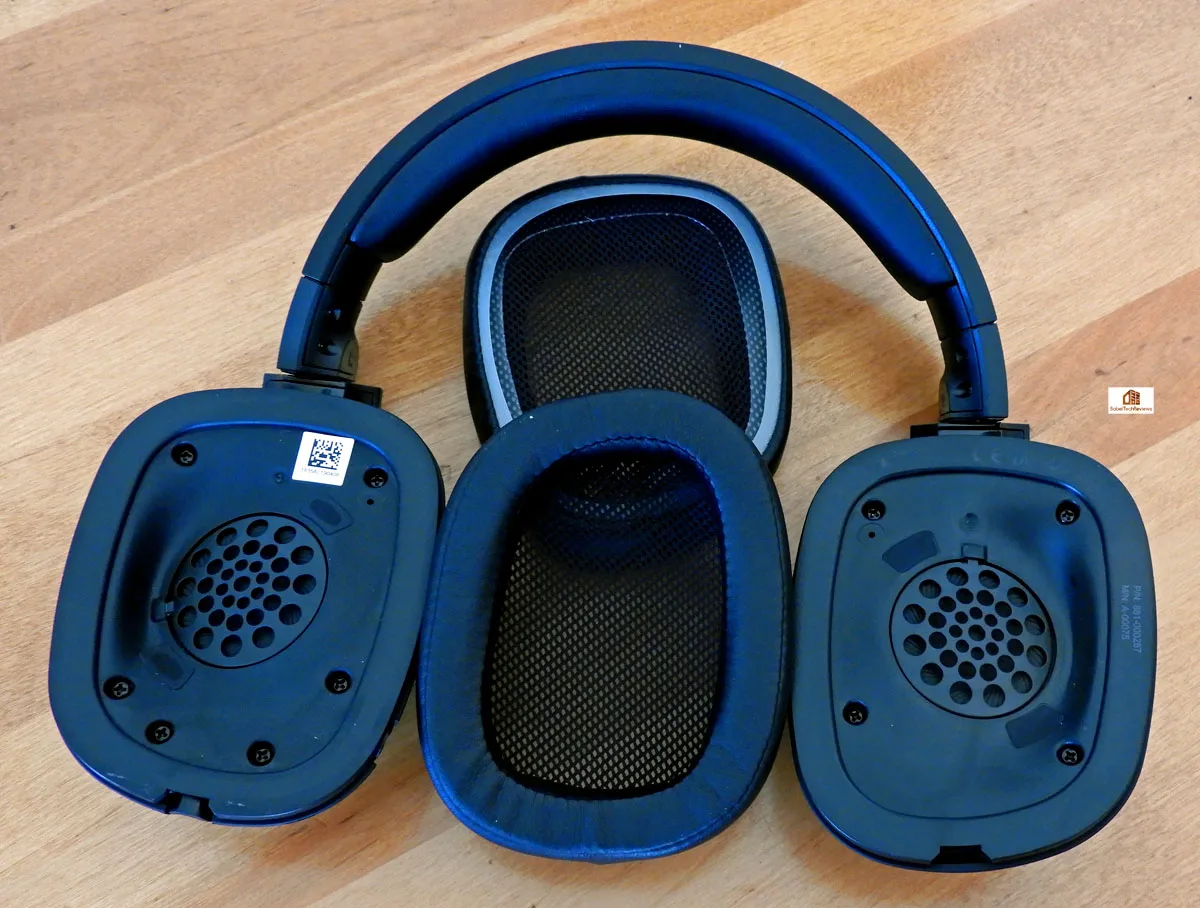 We noticed no audible quality difference using the extension cord which splits off into a separate microphone input, and appreciated the slight extra length it afforded when connecting to our 3.5mm audio jacks.
We noticed no audible quality difference using the extension cord which splits off into a separate microphone input, and appreciated the slight extra length it afforded when connecting to our 3.5mm audio jacks.
Installing the Logitech G PRO is simple. Plug in the jack(s), adjust the volume control on the cord, and play music, a movie, or a game. If you are playing a game and want to use the microphone, plug it in and attach the supplied extension cord which splits into a jack for audio and a jack for the microphone.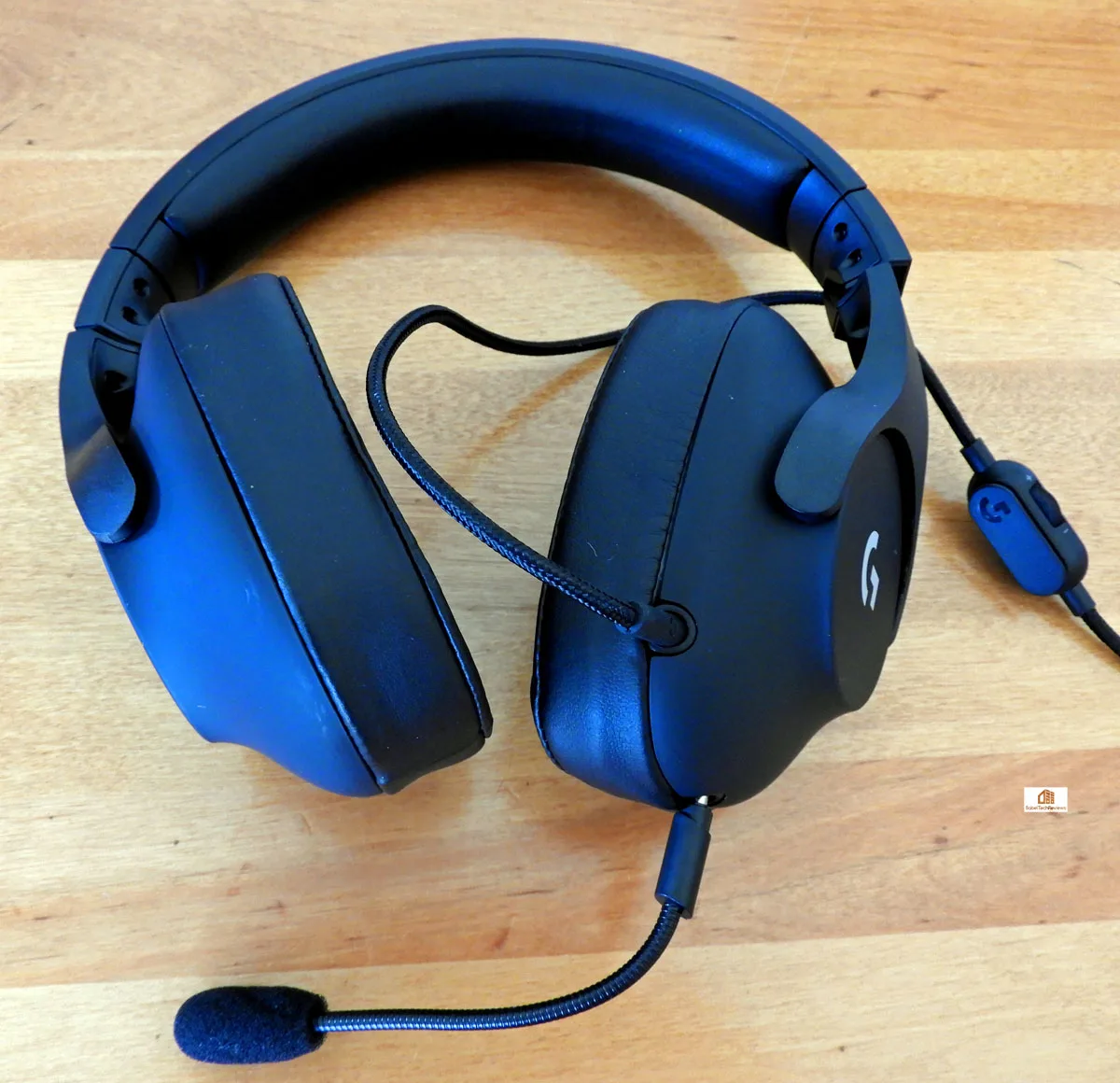
The Logitech G PRO is well-padded and its soft leatherette earpieces are incredibly comfortable, matching the comfort of the much lighter Grado open design headphones. Check your setup and make sure that you have the highest quality sound available under Windows. The Logitech G PRO is well-equipped for gaming and music, so let’s audition them critically.
Listening Tests
For our listening tests, we used the Logitech G PRO almost daily since we got them from Logitech last week for everything audio-related including for many hours of gaming. Playing certain video games which use audio clues for positionality, requires the gamer to constantly listen for them. Sensing accurate sound directional is crucial to surviving in games like Alien Isolation when being tracked by the alien or hiding from human survivors or from synthetics. Single player or multiplayer games like Call of Duty: Black Ops 4 also require being able receive directional audio cues as well as communicating effectively with your teammates.
The Logitech G PRO, the Cloud headset and the Grados are all stereo phones using two drivers, one for each ear, and the gaming positionality and the soundstage are decent but not quite the same as with using 7.1 headphones with a 7.1 source even when Dolby Atmos or Windows Sonic are used. Professional gamers sometimes choose a 7.1 capable headset while music lovers and casual gamers always pick stereo since 7.1 needs to be switched off for music.
Music
For our music, we chose the well-recorded DVDs of Steely Dan and Carlos Santana that this editor is very familiar with as well as some live recordings of Israel Kamakawiwo’ole. We did not run synthetic audio tests as they absolutely cannot tell you how headphones or headsets really sound when listening critically to music. That is what trained ears are for!
First up, we listened to our Grado SR60e series headphones. These headphones are the replacement for our go-to music headphones after our original Grado SR60s failed after nearly 15 years of use. Although our three test headsets are each quite different in design and purpose, they are all remarkably comfortable, and may be worn for many hours on end, with the Logitech G PRO being the most comfortable overall for long sessions.
As headphones for reproducing music, the Grado SR 60e is by far more accurate and they sound better overall, depending on what kind of music that you play. If the music requires heavy bass like rap or hard rock, then one might prefer the Cloud although it is not accurate and the mid bass punch tends to obscure the vocals somewhat. The G PRO worked well for vocals but its bass is lacking as well as the highest frequencies. For Jazz, acoustic, vocals, and for general listening, the open air design Grado SR60e headphones are our favorite for music reproduction
With the Grados, once can hear the transients and the shimmering detail of the high end that are somewhat muted by the Logitech G PRO and with the Cloud. The Cloud tends to over emphasize the treble which is slightly fatiguing as well as the bass, while not deemphasizing the midrange too badly except for the vocals which are hard to distinguish from each other when there are multiple singers in harmony.
All three headphones give a good stereo music stage with fair imaging, and the Cloud gave far more bass than the Grados or the G PRO, although Grado is more accurate as far down as it goes. The G PRO simply doesn’t have a lot of deep bass, but tends to have a slight mid-bass punch which works well for gaming, but not so well for music, and it also accentuates the vocal range. The SR60s are never strident nor shrill, and listening to music never gets tiring as it does with the Cloud.
The Grado SR 60e uses 40mm drivers and they have cut off the low bass, and as a trade-off, give a near-perfect mid-bass and midrange together with shimmering highs when the right album is played. The Grados were released in the mid-90s for $79, and they soon gained a reputation for being great for portable devices, as well as accurate, musical, and warm compared to most of the sonic junk that passed for headphones at the time. If you listen primarily to music, you would do best with the Grado SR60e, with the original Cloud a much more distant second. The G PRO falls into a close third place for music reproduction just behind the Cloud in this reviewer’s opinion.
Gaming
The Grados may have better imaging for music reproduction, yet either of the headsets work better overall for gaming. It’s a matter of what a gamer wants. If you want “audiophile” and accurate music reproduction, you do not want a gaming headset at all. But if you want a great sounding gaming headset that includes a good mic and are wonderfully comfortable for a reasonable price, the Logitech G PRO should be at the top of your list with the Cloud following in second place with a weaker microphone setup.
However, what makes the Logitech G PRO stand out is their comfort over extended gaming sessions, even for many hours at a time. Their comfort is absolutely amazing for an under ninety dollar headset. The Grados are very comfortable, but they are open design, which means you hear what is going on around you and irritate anyone else that is nearby. With the Cloud or the Logitech G PRO, you are sealed off in your own world and the isolation is similar between them.
The ability of the Logitech G PRO to block out the world is exceptional. Using the Logitech G PRO, it blocks most of the sounds out from a noisy environment, and even with low volume it is possible to concentrate on the music or the game without being distracted or annoyed by anything going on around you.
For gaming, the Logitech G PRO absolutely excels. The G PRO rivals the Cloud in every aspect of gaming, with its advantage of being even lighter and thus slightly more comfortable. All of the issues the Logitech G PRO has with music reproduction are absent when playing a game, and being able to hear audio clues as to enemy positions are just as good or better than with the Cloud. Best of all the G PRO’s microphone is decent for use in multiplayer or for Discord and your voice will be clearer and more distinct to your team mates than when using the Cloud.
For gaming when playing any of our test games, our experience was just as good or better with the Logitech G PRO than with the Cloud, and this is high praise indeed. In fact, the Grado SR60e lacked the excitement and the mid-bass punch that these games revel in with explosions and sound effects. Although the spatial audio directionality was similar for all three sets, the edge goes to the G PRO which excels at being able to help the player to clearly distinguish the nuances of one sound from another.
Choose your headphones or headset carefully since a quality pair are usually expected to last a long time and the G PRO’s warranty is two years. For under $90, the Logitech G PRO is a very good gaming headset that not only sounds good but looks great and is well-built
Conclusion
Pros
- As a gaming headset, the Logitech G PRO gives good sound and excellent audio cues for gaming.
- Good sound, elegant looks, and great features abound for the Logitech G PRO’s light weight, size and price range.
- Comfort. The Logitech G PRO is extraordinarily comfortable for a closed headset.
- Quiet Isolation. You can block out almost everything wearing your Logitech G PRO headset
- The earpieces fold flat for walking around with it or for travel.
- The microphone is excellent and it is detachable.
Cons
- Music reproduction is only fair.
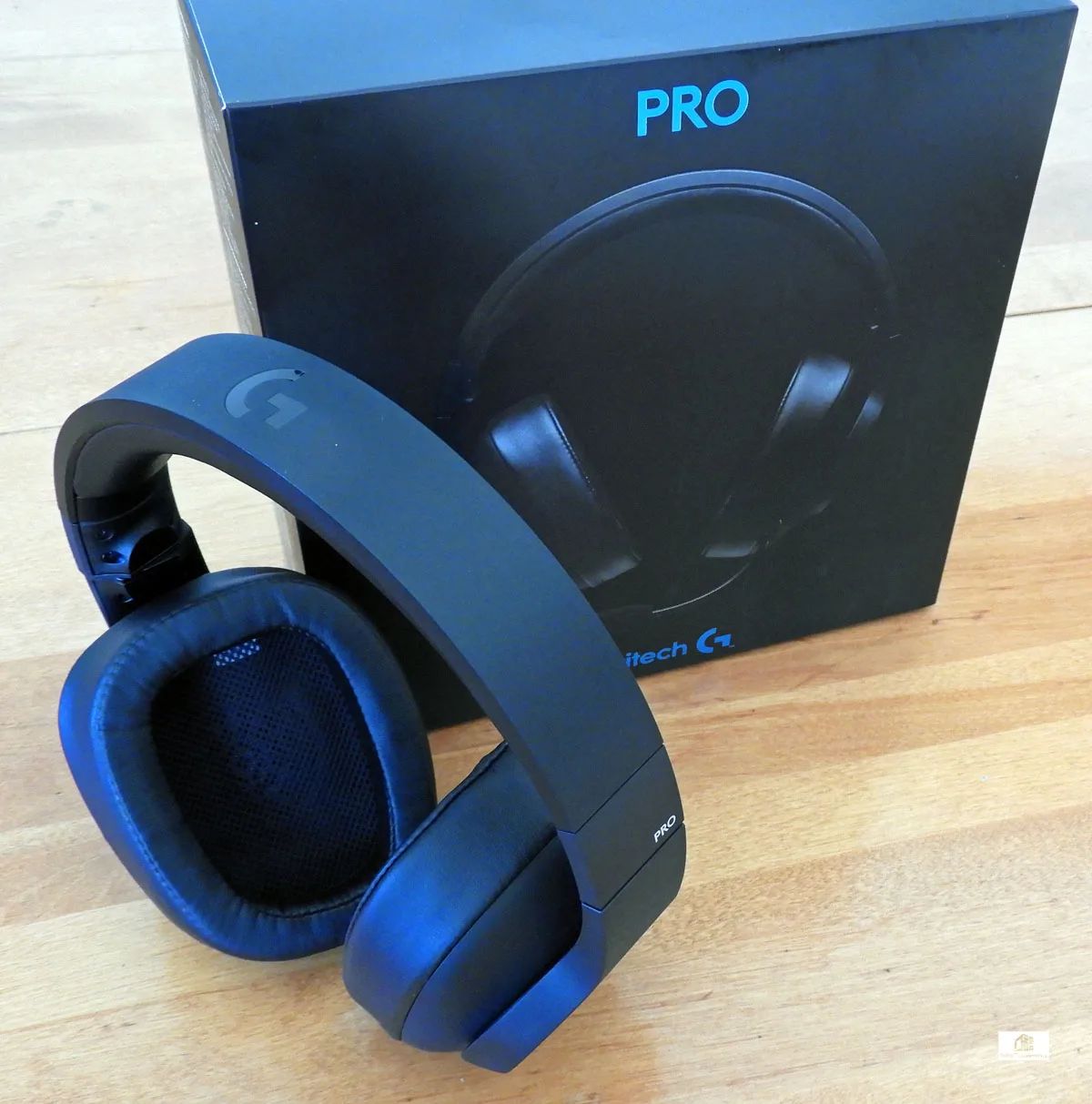 If you want to game like a pro using a good-looking, comfortable, and well-built headset, the Logitech G PRO gaming headset is a very good choice for $89 and it delivers in all departments except for music reproduction. It excels as a gaming headset with an exceptionally good microphone, and it offers excellent directional audio cues for singleplayer, multiplayer, and eSport gamers.
If you want to game like a pro using a good-looking, comfortable, and well-built headset, the Logitech G PRO gaming headset is a very good choice for $89 and it delivers in all departments except for music reproduction. It excels as a gaming headset with an exceptionally good microphone, and it offers excellent directional audio cues for singleplayer, multiplayer, and eSport gamers.
The Logitech G PRO is recommended as a very good gaming headset value and it deserves BTR’s “Editor’s Choice” Award.
Stay tuned, we have just received EVGA’s Nu Audio audiophile sound card and will be bringing you a full review of it shortly.
Happy Gaming!
